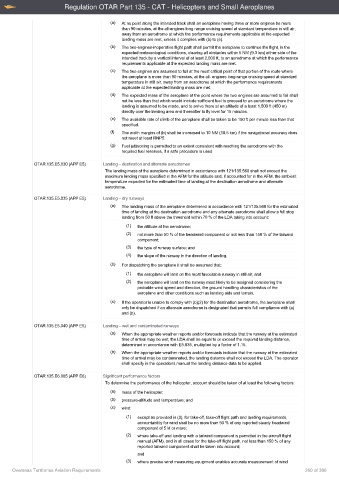Page 260 - Overseas Territories Aviation Requirements Consolidated - Total AOC
P. 260
Regulation OTAR Part 135 - CAT - Helicopters and Small Aeroplanes
(a) At no point along the intended track shall an aeroplane having three or more engines be more
than 90 minutes, at the all-engines long range cruising speed at standard temperature in still air,
away from an aerodrome at which the performance requirements applicable at the expected
landing mass are met, unless it complies with (b) to (e).
(b) The two-engines-inoperative flight path shall permit the aeroplane to continue the flight, in the
expected meteorological conditions, clearing all obstacles within 5 NM (9.3 km) either side of the
intended track by a vertical interval of at least 2,000 ft, to an aerodrome at which the performance
requirements applicable at the expected landing mass are met.
(c) The two engines are assumed to fail at the most critical point of that portion of the route where
the aeroplane is more than 90 minutes, at the all- engines long range cruising speed at standard
temperature in still air, away from an aerodrome at which the performance requirements
applicable at the expected landing mass are met.
(d) The expected mass of the aeroplane at the point where the two engines are assumed to fail shall
not be less than that which would include sufficient fuel to proceed to an aerodrome where the
landing is assumed to be made, and to arrive there at an altitude of a least 1,500 ft (450 m)
directly over the landing area and thereafter to fly level for 15 minutes.
(e) The available rate of climb of the aeroplane shall be taken to be 150 ft per minute less than that
specified.
(f) The width margins of (b) shall be increased to 10 NM (18.5 km) if the navigational accuracy does
not meet at least RNP5.
(g) Fuel jettisoning is permitted to an extent consistent with reaching the aerodrome with the
required fuel reserves, if a safe procedure is used.
OTAR.135.E5.030 (APP E5) Landing – destination and alternate aerodromes
The landing mass of the aeroplane determined in accordance with 121/135.560 shall not exceed the
maximum landing mass specified in the AFM for the altitude and, if accounted for in the AFM, the ambient
temperature expected for the estimated time of landing at the destination aerodrome and alternate
aerodrome.
OTAR.135.E5.035 (APP E5) Landing – dry runways
(a) The landing mass of the aeroplane determined in accordance with 121/135.560 for the estimated
time of landing at the destination aerodrome and any alternate aerodrome shall allow a full stop
landing from 50 ft above the threshold within 70 % of the LDA taking into account:
(1) the altitude at the aerodrome;
(2) not more than 50 % of the headwind component or not less than 150 % of the tailwind
component;
(3) the type of runway surface; and
(4) the slope of the runway in the direction of landing.
(b) For dispatching the aeroplane it shall be assumed that:
(1) the aeroplane will land on the most favourable runway in still air; and
(2) the aeroplane will land on the runway most likely to be assigned considering the
probable wind speed and direction, the ground handling characteristics of the
aeroplane and other conditions such as landing aids and terrain.
(c) If the operator is unable to comply with (b)(2) for the destination aerodrome, the aeroplane shall
only be dispatched if an alternate aerodrome is designated that permits full compliance with (a)
and (b).
OTAR.135.E5.040 (APP E5) Landing – wet and contaminated runways
(a) When the appropriate weather reports and/or forecasts indicate that the runway at the estimated
time of arrival may be wet, the LDA shall be equal to or exceed the required landing distance,
determined in accordance with E5.035, multiplied by a factor of 1.15.
(b) When the appropriate weather reports and/or forecasts indicate that the runway at the estimated
time of arrival may be contaminated, the landing distance shall not exceed the LDA. The operator
shall specify in the operations manual the landing distance data to be applied.
OTAR.135.E6.005 (APP E6) Significant performance factors
To determine the performance of the helicopter, account should be taken of at least the following factors:
(a) mass of the helicopter;
(b) pressure-altitude and temperature; and
(c) wind:
(1) except as provided in (3), for take-off, take-off flight path and landing requirements,
accountability for wind shall be no more than 50 % of any reported steady headwind
component of 5 kt or more;
(2) where take-off and landing with a tailwind component is permitted in the aircraft flight
manual (AFM), and in all cases for the take-off flight path, not less than 150 % of any
reported tailwind component shall be taken into account;
and
(3) where precise wind measuring equipment enables accurate measurement of wind
Overseas Territories Aviation Requirements 260 of 386

